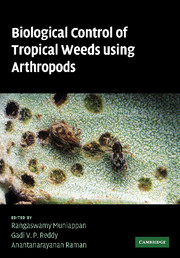Book contents
- Frontmatter
- Contents
- List of contributors
- Acknowledgments
- 1 Biological control of weeds in the tropics and sustainability
- 2 Acacia nilotica ssp. indica (L.) Willd. ex Del. (Mimosaceae)
- 3 Australian Acacia species (Mimosaceae) in South Africa
- 4 Ageratina adenophora (Sprengel) King and Robinson (Asteraceae)
- 5 Azolla filiculoides Lamarck (Azollaceae)
- 6 Cabomba caroliniana Gray (Cabombaceae)
- 7 Invasive cactus species (Cactaceae)
- 8 Chromolaena odorata (L.) King and Robinson (Asteraceae)
- 9 Clidemia hirta (L.) D. Don (Melastomataceae)
- 10 Coccinia grandis (L.) Voigt (Cucurbitaceae)
- 11 Eichhornia crassipes (Mart.) Solms–Laub. (Pontederiaceae)
- 12 Lantana camara Linn. (Verbenaceae)
- 13 Mimosa diplotricha C. Wright ex Sauvalle (Mimosaceae)
- 14 Mimosa pigra L. (Leguminosae)
- 15 Parthenium hysterophorus L. (Asteraceae)
- 16 Passiflora mollissima (HBK) Bailey (Passifloraceae)
- 17 Pistia stratiotes L. (Araceae)
- 18 Prosopis species (Leguminosae)
- 19 Salvinia molesta D. S. Mitchell (Salviniaceae)
- 20 Solanum mauritianum Scopoli (Solanaceae)
- 21 Application of natural antagonists including arthropods to resist weedy Striga (Oranbanchaceae) in tropical agroecosystems
- 22 Biological control of weeds in India
- 23 The role of International Institute of Tropical Agriculture in biological control of weeds
- 24 The role of Secretariat of the Pacific Community in the biological control of weeds in the Pacific Islands region – past, present, and future activities
- Index
2 - Acacia nilotica ssp. indica (L.) Willd. ex Del. (Mimosaceae)
Published online by Cambridge University Press: 04 August 2010
- Frontmatter
- Contents
- List of contributors
- Acknowledgments
- 1 Biological control of weeds in the tropics and sustainability
- 2 Acacia nilotica ssp. indica (L.) Willd. ex Del. (Mimosaceae)
- 3 Australian Acacia species (Mimosaceae) in South Africa
- 4 Ageratina adenophora (Sprengel) King and Robinson (Asteraceae)
- 5 Azolla filiculoides Lamarck (Azollaceae)
- 6 Cabomba caroliniana Gray (Cabombaceae)
- 7 Invasive cactus species (Cactaceae)
- 8 Chromolaena odorata (L.) King and Robinson (Asteraceae)
- 9 Clidemia hirta (L.) D. Don (Melastomataceae)
- 10 Coccinia grandis (L.) Voigt (Cucurbitaceae)
- 11 Eichhornia crassipes (Mart.) Solms–Laub. (Pontederiaceae)
- 12 Lantana camara Linn. (Verbenaceae)
- 13 Mimosa diplotricha C. Wright ex Sauvalle (Mimosaceae)
- 14 Mimosa pigra L. (Leguminosae)
- 15 Parthenium hysterophorus L. (Asteraceae)
- 16 Passiflora mollissima (HBK) Bailey (Passifloraceae)
- 17 Pistia stratiotes L. (Araceae)
- 18 Prosopis species (Leguminosae)
- 19 Salvinia molesta D. S. Mitchell (Salviniaceae)
- 20 Solanum mauritianum Scopoli (Solanaceae)
- 21 Application of natural antagonists including arthropods to resist weedy Striga (Oranbanchaceae) in tropical agroecosystems
- 22 Biological control of weeds in India
- 23 The role of International Institute of Tropical Agriculture in biological control of weeds
- 24 The role of Secretariat of the Pacific Community in the biological control of weeds in the Pacific Islands region – past, present, and future activities
- Index
Summary
Introduction
Acacia nilotica (L.) Willd. ex Del. (Mimosaceae), known as prickly acacia in Australia, is native to the tropics and subtropics of Africa, the Middle East, and the Indian subcontinent. Under the new classification system, the subgenus Acacia will be Vachellia Wright & Arnold (Seigler and Ebinger, 2006). Acacia nilotica was introduced into Queensland from India in the late 1890s as an ornamental tree (Bolton, 1989). Since the mid 1920s, A. nilotica was widely used as a shade tree and fodder for sheep in western Queensland. A change from sheep to cattle as the predominant grazing species and a series of wet years resulted in its spread. Acacia nilotica was declared a noxious weed in Queensland in 1957, and is now a weed of national significance in Australia. In the Mitchell grass downs of western Queensland, which cover around 22m ha of natural grassland, A. nilotica has infested more than 6m ha (Fig. 2.1) and 2000 km of bore drains (Mackey, 1997; Spies and March, 2004). Acacia nilotica is also present in the coastal regions of Queensland, the Northern Territory, and Western Australia (Spies and March, 2004), and has the potential to infest vast areas of Australia's native grassland ecosystems (Fig. 2.2) (Kriticos et al., 2003a).
Acacia nilotica populations in Australia consist of thorny large shrubs or small trees, growing 4–5 m high, occasionally reaching 10m. Seedling recruitment is linked to rainfall pattern, and under favorable conditions, young plants attain maturity in 2–5 years (Fig. 2.3).
- Type
- Chapter
- Information
- Biological Control of Tropical Weeds Using Arthropods , pp. 17 - 37Publisher: Cambridge University PressPrint publication year: 2009
- 10
- Cited by

